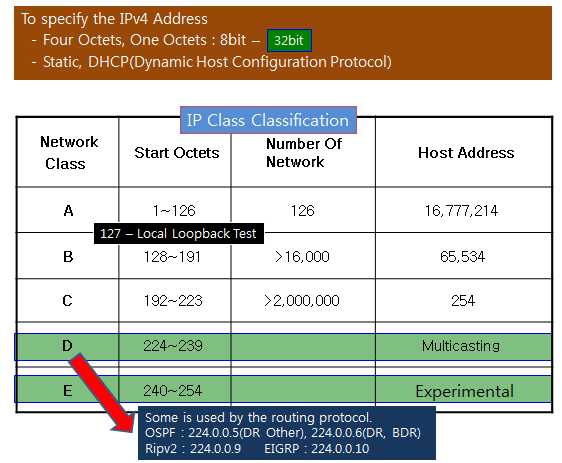Hello Steemians!
This post is the third post of the article project and we will learn about the address.
The addresses used for communication include MAC addresses, Port addresses, etc., in addition to commonly known IP addresses. IP addresses are required for mutual communication, because if the addressee does not know the address or if the address is incorrect, the delivery may be problematic.
The IP address can be divided into public IP authorized by the IANA and non-public (private IP). Static IP is used by inputting direct address according to the allocation method. Dynamic IP allocated by DHCP Server is used There are IPv4 and IPv6 addresses depending on the version.
The public IP range should never be duplicated in an address area that is exposed to the outside, while non-public (private) IP may not be exposed to the outside, so it may overlap.
Of course, even if you use a private IP, you should not duplicate it in the same network.
In order to assign the IP address automatically according to the request of the client, DHCP will build the DHCP server in practice.
In the case of the old IP address, Classes A to E are used as Classes, but today Class is not meaningful.
It is a CIDR method that distinguishes networks based on IP address and Subnet Mask.
The picture below represents the old class-based address. Note that 127.x.x.x addresses are reserved for local loopback testing.

The IPv4 address is 32 bits long, the IPv6 address is 128 bits long, v4 can be allocated to 32 of 2, and v6 can be assigned to 128 of 2, which is enough to connect to the current Internet.
In short, the address is that there is an international organization that needs and manages the communication. Let's take a look at the subnet mask mentioned above.
The subnet mask value is a value that tells you which network the addressed system is on.
It is a value that distinguishes between the person who lives in our house (the internal network) and the person who lives in another house (the external network). By this network distinction, you will know where to communicate.
The subnet mask value, which distinguishes the network, can be used to differentiate the network, which is called subnetting.
Subnetting is the reason for the lack of address and it is necessary for setting VLAN and so on. The reason for the lack of addresses in the IPv4 address scheme is that in the early days,
This is because we assigned it indiscriminately.
Subnetting is basically divided into a network ID (bit value "1") and a host ID (bit value "0") in case of IPv4 address,
If you move to the right of the network portion of the subnet (the subnet mask expands to the right), you can host it per network for additional subnets.
Formula 2: n is the number of extension bits, and 2 subnets are created. For example, if the original value of 255.255.255.0 is extended to a value of 255.255.255.128
The formula divides the original network into two completely different networks.
Formula (2 :2)-2 The number of assignable IP addresses per subnetwork, where n is the number of remaining bits "0".
In the example above, 2 is the 7th-2. The two addresses that can not be assigned are reserved for the first (network bandwidth) address and the last (broadcast) address of the band.
First of all, let's take a closer look at this while practicing.
We will also look at the detailed structure of the IPv6 address when the exercise is going on.
In the next installment, I'll show you how to set up your Cisco device in practice.
Have a nice day